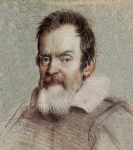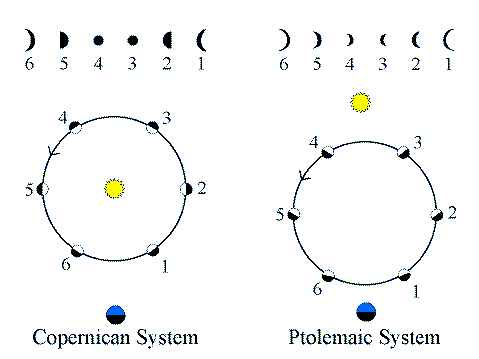Lecture 16: "The Starry Messenger":
Galileo Galilei & the Telescope
Key Ideas:
Galileo Galilei was the first modern astronomer.
Important Discoveries with the telescope:
- Moons of Jupiter
- Phases of Venus
- Craters and Mountains on the Moon
- Sunspots
Confrontation with the Church
Galileo Galilei (1564-1642)

Italian Contemporary of Kepler, and in many ways the first
modern scientist
- Gifted mathematician
- Brilliant observer and experimenter
Preferred experimentation and measurement to philosophical rhetoric.
- Staunch anti-Aristotelian in many ways
- Often at odds with the scholarly establishment
The Telescope
The telescope was invented in 1608 by Dutch spectacle makers. Tradition
says this was Hans Lipperhey, but no one really knows who was the first.
Word spread fast:
- In April 1609, you could buy one in eyeglass shops in Paris.
- First one reached Italy in August of 1609
Galileo's Telescope
Galileo learned about the telescope in 1609, but did not get a chance to
see one.
- Based on a description, and acquainted with lens making,
he made his own.
- He solved many technical problems, and came up with a design
that produced good-quality images with a magnifying power
of 20x.
He soon turned his telescope on the night sky.
"...a most beautiful & delightful
sight."
In 1610, Galileo published his telescopic observations in the
Sidereus Nucius (The Starry Messenger).
Later observations were published in letters, and in a longer work,
The Assayer, in 1623.
Among these observations were:
- Craters and Mountains on the Moon
- Sunspots & Solar Rotation
- Moons of Jupiter
- Phases of Venus
Note: Galileo made other important observations, including that
the Milky Way is made of myriads of faint stars, and and the odd shape
of Saturn. The latter turned out to be Saturn's Rings which were just
beyond the ability of Galileo's telescope to discern. They were
correctly recognized as rings by the astronomer Hevelius in 1656.
Neither of these observations concern us directly here.
Moon Craters & Mountains
Galileo found craters and mountains on the Moon:
- Moon was not a smooth, perfect sphere as taught by the
Aristotle and Ptolemy.
- Surface was "... rough and uneven, and just like the
surface of the Earth itself..."
- Galileo was able to measure the heights of lunar
mountains using their shadows.
Conclusion: The Moon was another world like the Earth.
Spots on the Sun
Galileo observed sunspots:
- Bright surface of the Sun had dark spots that changed and
moved across its surface.
- Discerned solar rotation over time.
- Sun was not a perfect body, and was in fact rotating.
- Contemporaries also reported them (they appear in Chinese
records as early as 28 BC, but nobody in the west had
access to this knowledge).
Conclusions:
- If a huge object like the Sun can rotate, why not the Earth?
- The Sun, too, was imperfect, contrary to Aristotelian teachings.
The Moons of Jupiter
Galileo discovered 4 moons orbiting Jupiter
- Jupiter appeared as a disk.
- 4 points of light that followed it and moved in orbits around it.
- Deduced that they were moons (We now call them the Galilean Satellites
of Jupiter)
Conclusion: The Earth is not the only center of motion in the Universe.
- There was a solar system in miniature around Jupiter for all to see!
The Phases of Venus
Venus goes through phases like the Moon

Click on the image to view full size (11Kb)
- Order of phases and change in diameter proved
conclusively that Venus orbited the Sun.
- Ptolemaic theory predicted the opposite behavior.
Conclusion: The Sun was also a center of motion.
- This itself did not prove the Copernican system (it was also
consistent with the Tychonic system), but it was inconsistent with the
prevailing Ptolemaic system.
The Impact of Galileo's Observations
The impact was immediate and forceful:
- Skeptics claimed that the telescope was lying
(and Galileo, too) and entrenched.
- Kepler was delighted, and soon got his own telescope, as
did many others.
- Many scholars began to take the Copernican system
seriously as a physical system.
The discoveries brought Galileo immediate fame throughout Europe.
Perhaps most importantly, with the telescope everyone could literally
see it for themselves. This, more than all the profound philosophical
speculations or obscure mathematical arguments, was behind the
tremendous impact of Galileo's observations. These phenomena were
observed facts of nature, and had to be confronted.
Galileo knew he could hold his own on the ground of scholarly
confrontation. He was now by far the most famous scientist in Europe,
and immensely influential. This position led him to miscalculate his
own influence, and to badly misjudge the influence of his enemies.
Troubles with the Church.
1616:
- The Church officially declares that the heliocentric
theory is "philosophically false and at least an
erroneous belief."
- De Revolutionibus was officially banned.
- Galileo was called to an audience with Cardinal Robert
Bellarmine, who cautioned him verbally to stop teaching
and defending the Copernican model in public.
1624:
- Galileo writes "A Dialogue on the Two Chief World
Systems", ably defending the Copernican system.
- Seeks permission from Pope Urban VIII to publish it, but
is rebuffed.
1632:
- Galileo's Dialogue is published in Florence, written
in Italian (Tuscan), not Latin.
- It was an instant success & widely acclaimed.
- Galileo unfortunately played directly into the hand of his enemies.
The Trial of Galileo
1633:
- Galileo is summoned by the Roman Inquisition and a document is
produced alleging that Bellarmine in 1616 specifically forbade him to
discuss the Copernican system in any way (modern scholarship has shown
that this document is a forgery, or at best trumped up).
Galileo faced two specific charges:
- Disobedience of Bellarmine's 1616 order.
- Misleading censors who published his book.
What was really going on in the background was that enemies of Galileo
convinced Pope Urban VIII that a character in the Dialogue
named Simplicio who ineptly defended the Ptolemaic system was a thinly
veiled caricature of the Pope himself. This provided a pretext for
making an example of Galileo, albeit on trumped up charges. Galileo was
his own worst enemy in this situation, as he vastly overestimated his
influence in Rome, and the degree to which his well-deserved fame would
protect him.
Publicly humiliated and threatened with torture, Galileo had no choice
but to admit guilt, and "abjure, curse and detest the
aforesaid errors and heresies..."
House Arrest
Galileo was placed under house arrest at his villa in Arcetri near
Florence until his death in 1642.
Despite this, in 1636 he finished "The Two New
Sciences" describing his experiments in mechanics.
- Unable to get published due to his conviction, the
manuscript was smuggled out of Italy and published in
Protestant Leyden in 1638.
- This book helped lay the foundations of classical physics.
Eppur si muove (and still, it moves)
Galileo died, blind and under house arrest, on January 8, 1642.
On Christmas Day of that same year, Isaac Newton was born in
Woolsthorpe England.
In 1992, 350 years later, Pope John Paul II officially declared
Galileo innocent.
Return to [
Unit 3 Index
|
Astronomy 161 Main Page
]
Updated: 2007 October 4
Copyright © Richard W. Pogge,
All Rights Reserved.
